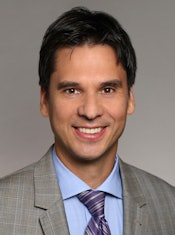
How will the dental students of the future cope with a rising mountain of debt? Will the big-data revolution trickle down to the average dental practice? These are just a few questions on the future of dentistry from a session at the recent American Association of Endodontists (AAE) annual meeting in San Francisco.
 Marko Vujicic, PhD, chief economist and vice president of the ADA Health Policy Institute. Image courtesy of the ADA.
Marko Vujicic, PhD, chief economist and vice president of the ADA Health Policy Institute. Image courtesy of the ADA.The session featured Marko Vujicic, PhD, and Gerald Glickman, DDS, JD, debating how major trends in dentistry are changing the field. Part one of our coverage focused on how fluctuating supply and demand is changing dentistry, while this part focuses on two trends that have the potential to revolutionize the dental industry, including the oncoming data revolution and changes in higher education.
"It's been almost 100 years of the status quo: how we practice, what we're paid," said Vujicic, chief economist and vice president of the ADA Health Policy Institute. "It's going to change."
Changes in higher education
Changes in higher education have the ability to affect the future of general dentistry and specialties. In recent years, more students are applying to dental school and residency programs, and those students have higher debt loads than ever before.
"The number of applicants [for dental school] is still very, very high, so dental schools have the pick of the litter," said Dr. Glickman, chair of the department of endodontics at Texas A&M University's Baylor College of Dentistry. "There was a 30% increase to endo specialty programs last year."
“It's been almost 100 years of the status quo: how we practice, what we're paid.”
"I'm blown away by the caliber of dentists," Vujicic said. "This is the smartest generation of dentists in history."
While the quality of dental school students and graduates may be higher than ever, the rising number of students applying to schools, especially graduate programs, is posing a unique challenge to those who run programs. In fact, Dr. Glickman noted that his school has brought in behavioral scientists to help out with the admissions process.
"The quality of people we're seeing is outstanding, but how do we address the issue of passion?" he asked. "The bottom line is we want our people to be successful."
Another issue tied in with dental school is rising debt levels. Students who leave dental school now are more likely to go into corporate or group practice, where there's a guaranteed salary, according to Dr. Glickman.
"The data does show that the students who leave dental school at this time, they aren't becoming employers, they're becoming employees," he said. "The debt load is unbelievable. People, on average, are leaving dental school with $250,000 in loans, but the debt load isn't deterring people from applying to specialty school."
The ADA is trying to quantify the recent trend of corporate practice, Vujicic noted. He mentioned that 8% of dentists are now in corporate practice, and the percentage of specialists in corporate practice is slightly lower, at 6% for endodontics.
The conversation can focus too much on debt, however, and not enough on career choices, he added. With the cost of higher education skyrocketing for every graduate, dentistry and dental specialties, even if they come with a higher amount of debt than before, are still an incredible return on investment compared with other programs, such as veterinary or law school.
"The punch line from the research program is that we talk about debt way too much when talking about career programs," he said. "Things like race, gender, and whether your parent was a dentist -- the effect of debt was washed away once we accounted for those."
The oncoming data revolution
The data revolution will be one of the biggest future forces to shape dentistry, according to Vujicic. The revolution can come in various forms, such as changing the fee-for-service model or providing relevant case studies on demand, he said.
Vujicic illustrated his point with a story about how he was frustrated that his own endodontist couldn't give him specific answers for how long his root canal treatment would last. He thinks once data become more accessible, dentists and specialists will be able to quickly pull case studies similar to a current procedure and use those for treatment planning and predictions.
"Wouldn't it be awesome if you could access 50 cases, and you would know what would happen to those 50 patients?" Vujicic asked. "Dentistry is completely in the Stone Age when it comes to evidence-based medicine. Given what we can do, a big revolution is coming in terms of big data."
The data revolution might also be accompanied by a change in business model from fee for service into "some kind of a process that rewards clinicians for outcomes," he said.
For instance, dentists could get rewarded for lowering their percentage of patients with caries, or endodontists could get paid for keeping a patient pain free or avoiding an extraction. He did warn that future models will have to take into account risk, so providers don't only accept easy patient cases.
And those about to live these changes -- the young dentists, endodontists, and other specialists -- should be ready to face the challenges head-on, Vujicic advised.
"You're going to be the generation that lives this change. You've got to set the rules," he said. "You can't think you're going to plug into your aunt's or uncle's practice and think you'll do things the same ways. You'll start with yesterday's model, and in 30 years it's going to be different."


















